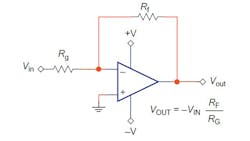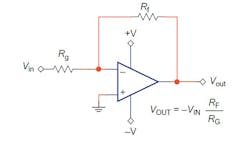Bruce Carter’s 4th edition of “Op Amps for Everyone” updates current technology associated with operational amplifiers, including some of the newer design aids. Carter mentions some of the early history of IC op amps that started with the µA709 designed by Bob Widlar. This was followed by the µA741 and hundreds more op amp ICs. Fig. 1 shows the schematic of a typical op amp.
Carter’s 280-page op amp book has the following chapters:
1. The Op Amps Place in the World
2. Review of Op Amp Basics
3. Separating and Managing AC and DC Gain
4. Different Types of Op Amps
5. Interfacing a Transducer to an Analog-to-Digital Converter
6. Active Filter Design Techniques
7. Using Op Amps for Radio Frequency Design
8. Designing Low Voltage Op Amp Circuits
9. Extreme Applications
10. Voltage Regulation
11. Other Applications
12. Manufacturer Design Aids
13. Common Application Mistakes
Appendices
A. Understanding Op Amp Parameters
B. Op Amp Noise Theory
C. Circuit Board Layout Techniques
D. Op Amp Circuit Collection
The Manufacturer Design Aids chapter includes information from Texas Istruments, Analog Devices and Linear Technology. “This chapter discusses some of the online resources available from semiconductor manufacturers. I include some of my experience with them and review them a bit. These online resources are subject to change at any time by the manufacturers, of course, and they own the names. I may seem a bit critical at times of some of the limitations and shortcomings, but I am genuinely impressed by the quality of free online offerings and the generosity of the companies who put them up there.”
“I do have some general comments regarding these online tools. Often, they contain hooks to encourage you to buy the “full, unlimited version” from a third party software author. The free versions of the programs may be feature limited, time limited, node limited, or have other limitations that “cripple” the software. You have to learn to live within the limitations. It is possible to get very creative in working around some of the limitations to the point where you rarely, if ever, have to worry about them. The goal, of course, is to do some serious engineering work and all of these design aids are focused in that direction. I cannot provide a user’s manual for these tools. Some of them are quite complex and it would take dozens or hundreds of pages to delve into them.”
Carter notes that “When one works as an analog applications engineer for many years supporting customer inquiries, some patterns begin to emerge. Inquiries run the gamut from those from inexperienced designers to those from analog design experts who have encountered something new and unusual that challenges even the best support engineer. Unfortunately, there are also inquiries that are bound to elicit a groan: mistakes the author has seen many times before and unfortunately will see many times again. It is hoped that this chapter will educate you about some of the most common mistakes, and save you from making them.” The chapter of common op amp mistakes provides insight into some of the common design problems, which include:
· Op Amp Operated at Less than Unity (or Specified) Gain
· Op Amp Used as a comparator
· Improper Termination of Unused Sections
· DC Gain
· Current Feedback Amplifier Mistakes
· Shorted Feedback Resistor
· Capacitor in the Feedback Loop
· Fully Differential Amplifier Mistakes
· Incorrect DC Operating Point
· Incorrect Common-Mode Range
· Incorrect Single-Ended Termination
· Improper Decoupling
The book is available at the Elsevier Store. Use this link: http://store.elsevier.com/product.jsp?isbn=9780123914958&utm_source=publicity&utm_medium=bkrev&utm_campaign=PwrElec
About the Author

Sam Davis Blog
Editor-In-Chief - Power Electronics
Sam Davis was the editor-in-chief of Power Electronics Technology magazine and website that is now part of Electronic Design. He has 18 years experience in electronic engineering design and management, six years in public relations and 25 years as a trade press editor. He holds a BSEE from Case-Western Reserve University, and did graduate work at the same school and UCLA. Sam was the editor for PCIM, the predecessor to Power Electronics Technology, from 1984 to 2004. His engineering experience includes circuit and system design for Litton Systems, Bunker-Ramo, Rocketdyne, and Clevite Corporation.. Design tasks included analog circuits, display systems, power supplies, underwater ordnance systems, and test systems. He also served as a program manager for a Litton Systems Navy program.
Sam is the author of Computer Data Displays, a book published by Prentice-Hall in the U.S. and Japan in 1969. He is also a recipient of the Jesse Neal Award for trade press editorial excellence, and has one patent for naval ship construction that simplifies electronic system integration.

